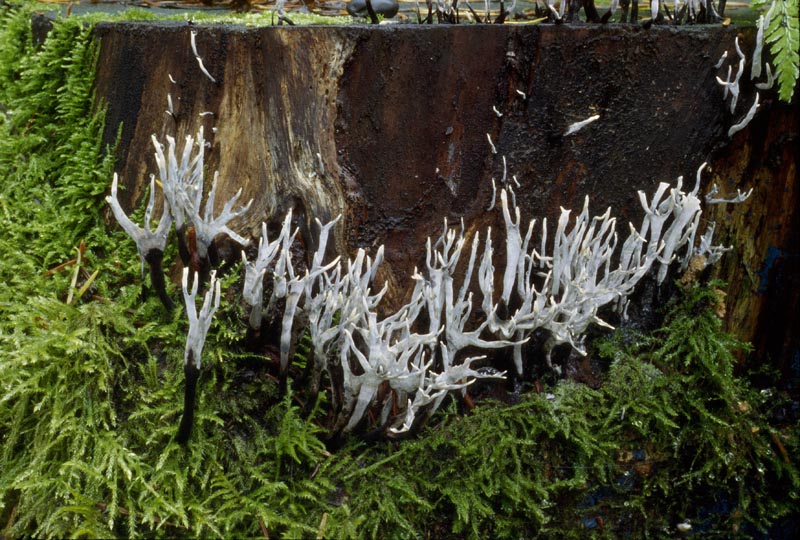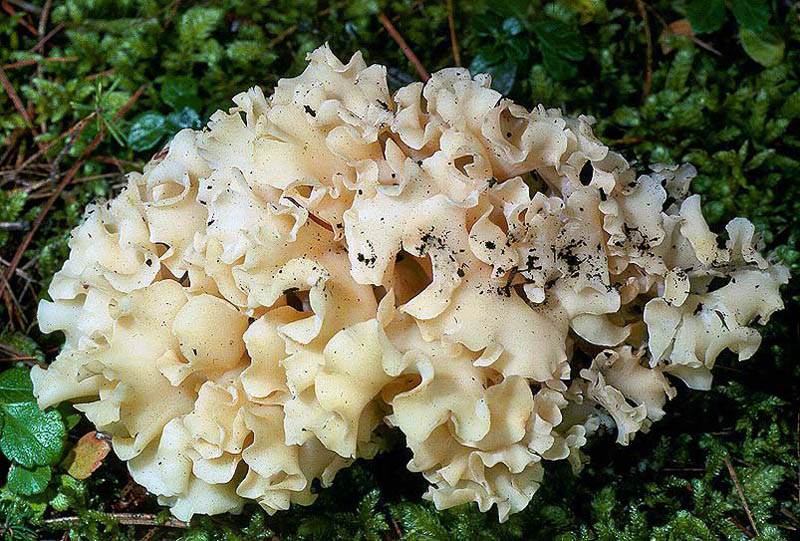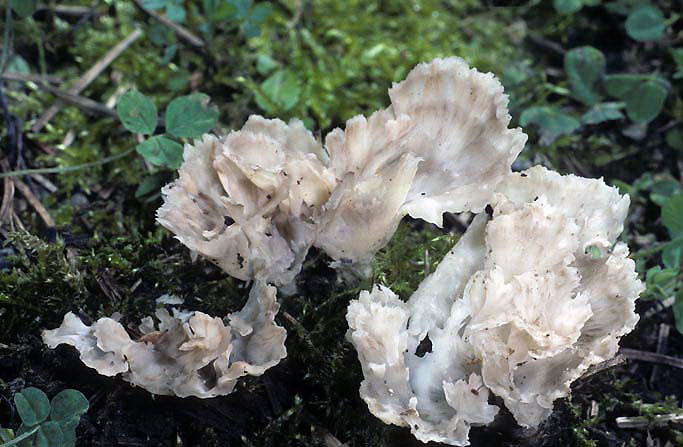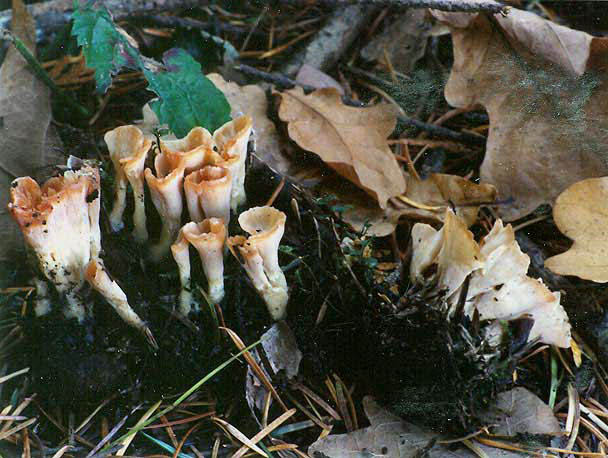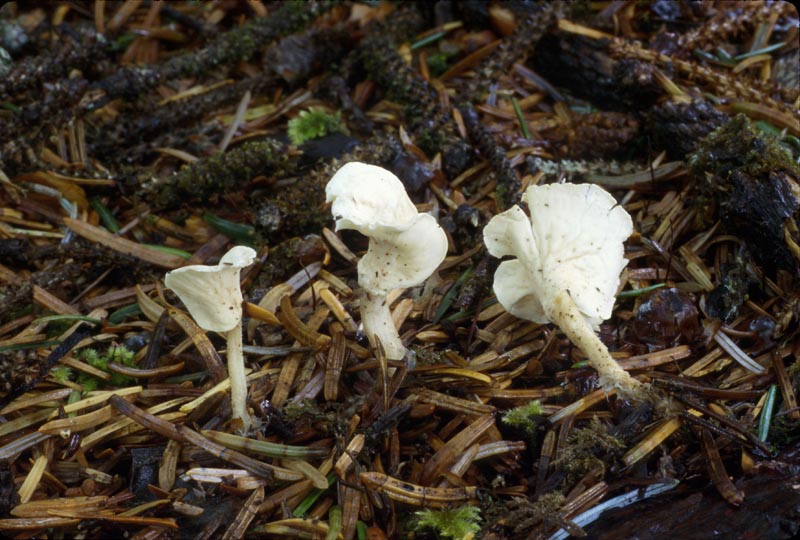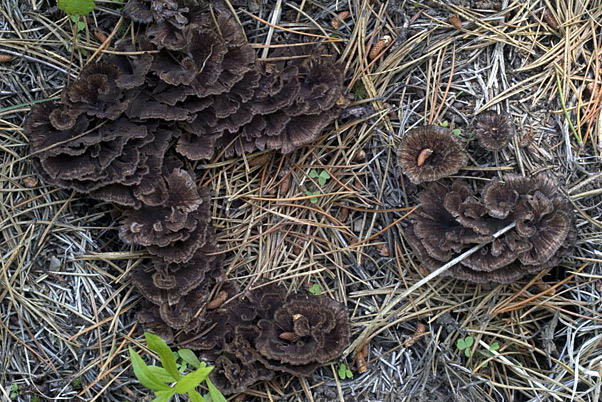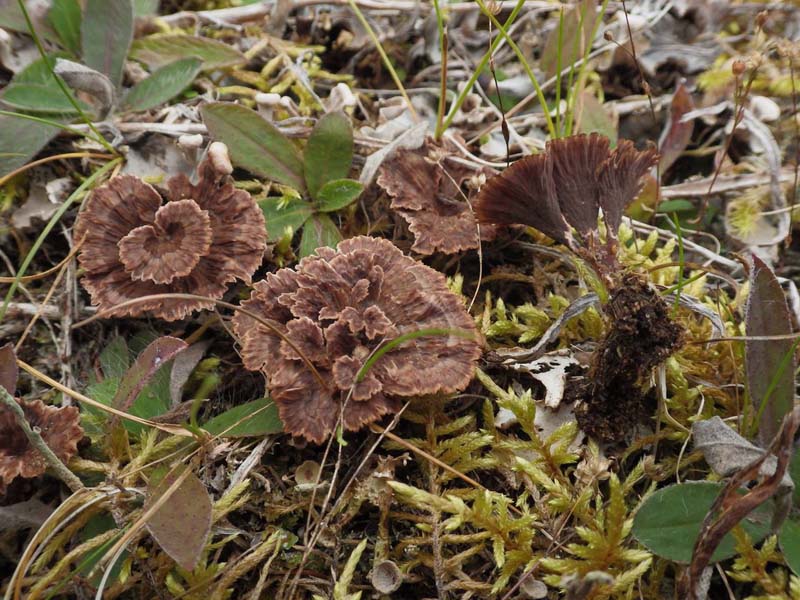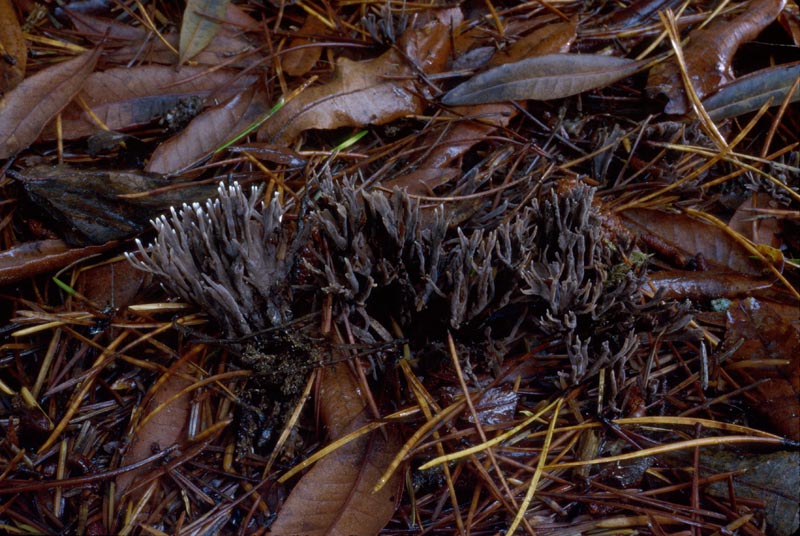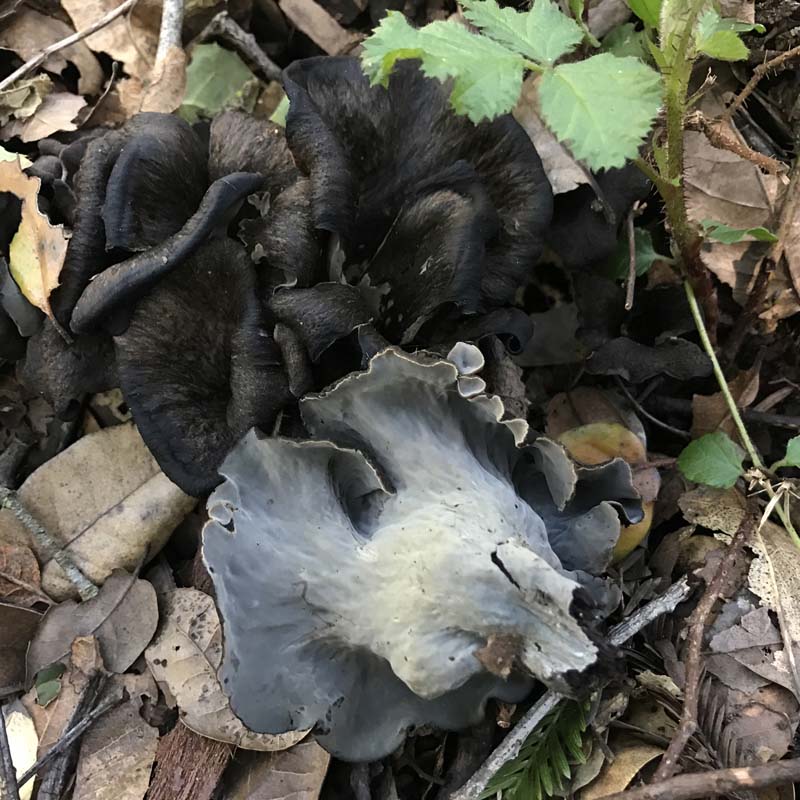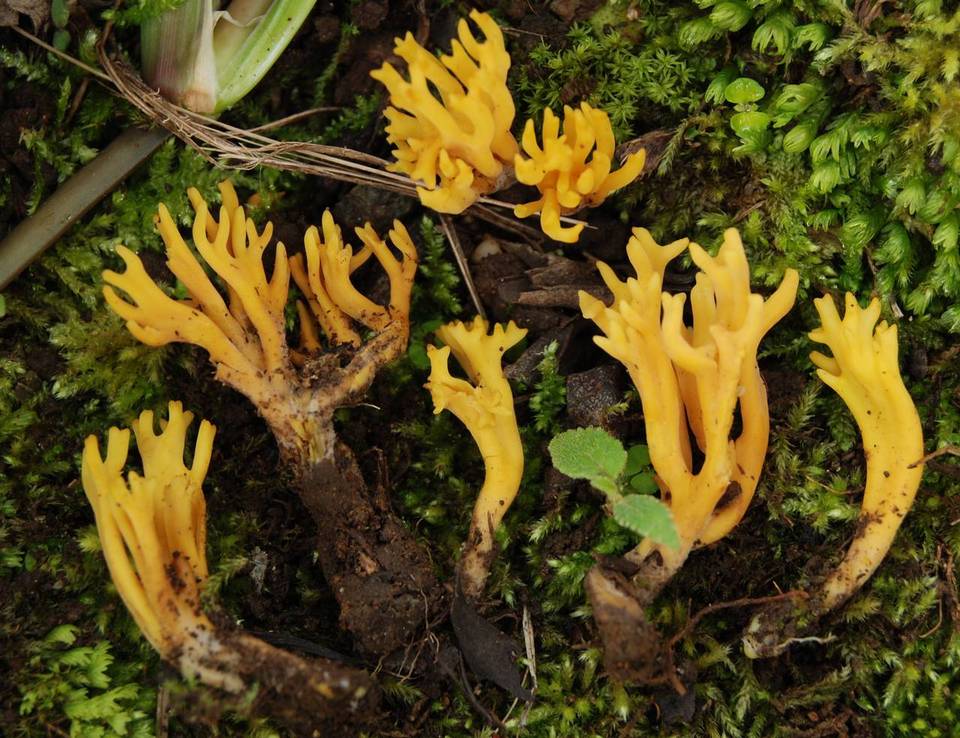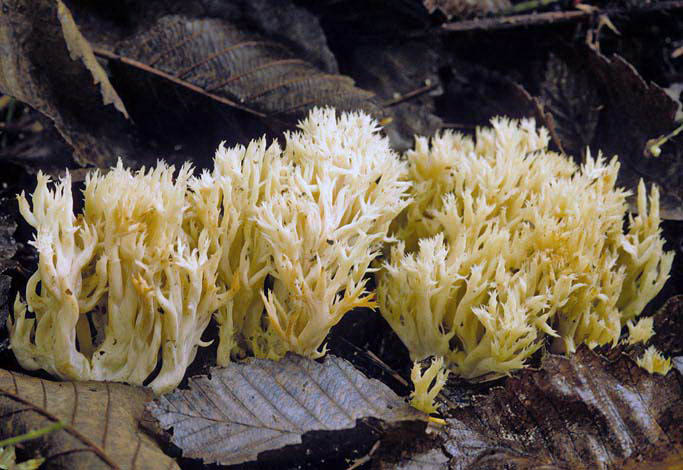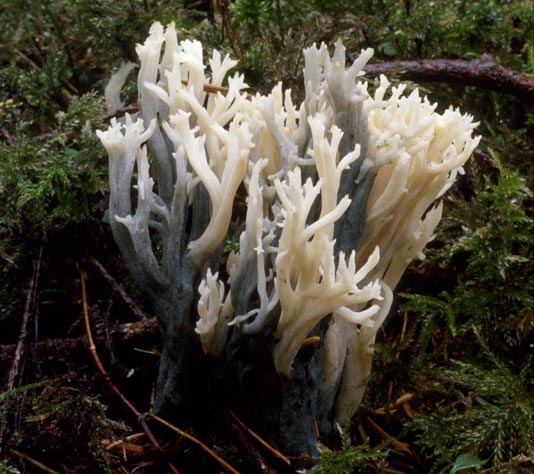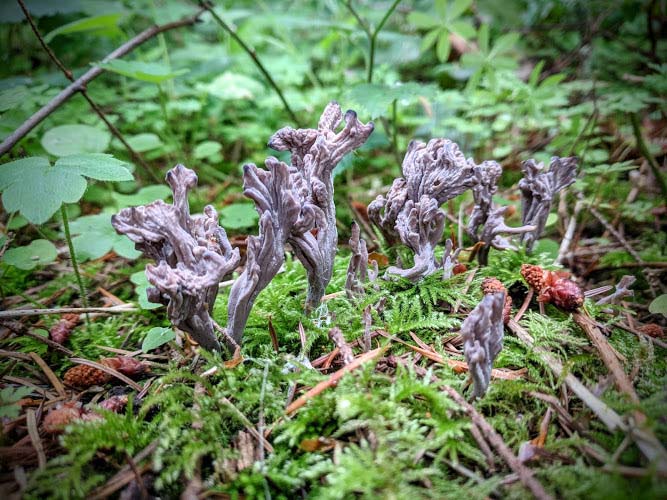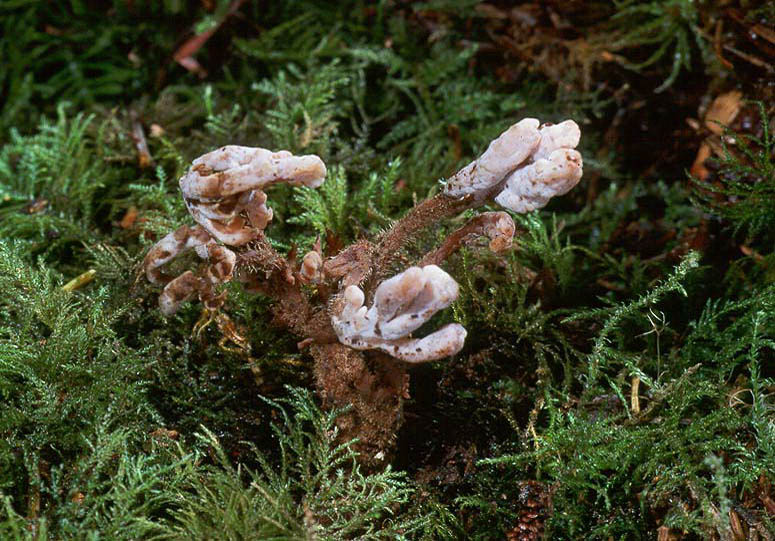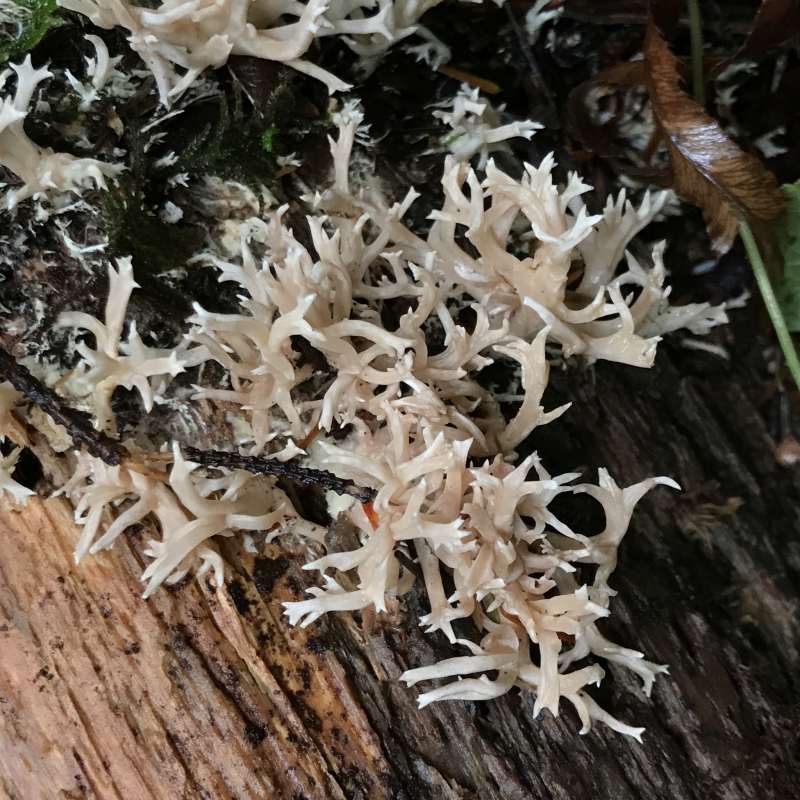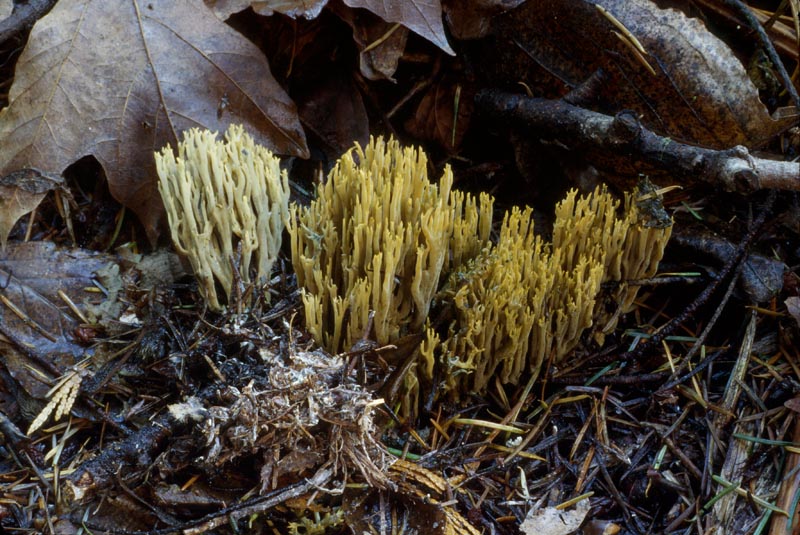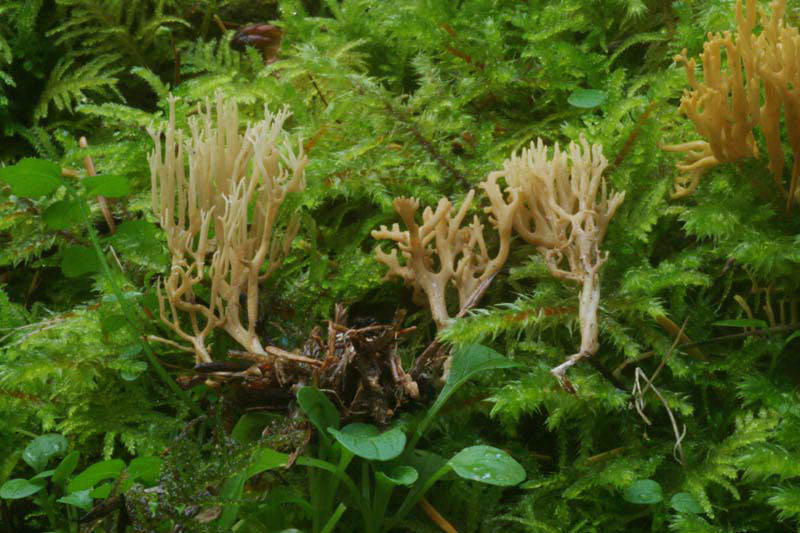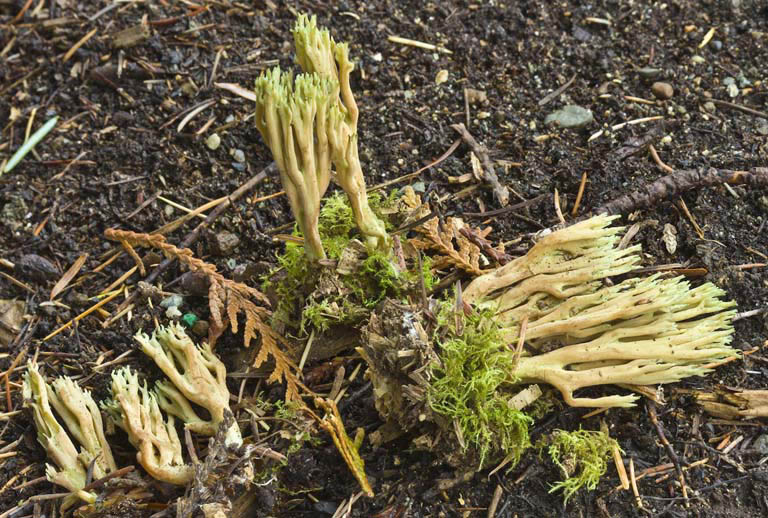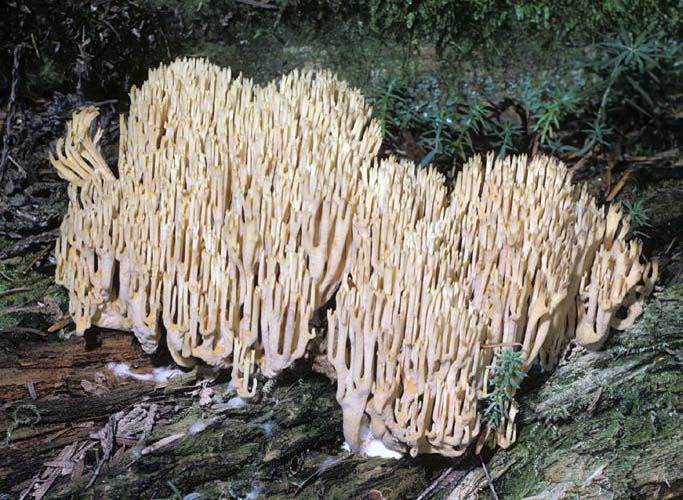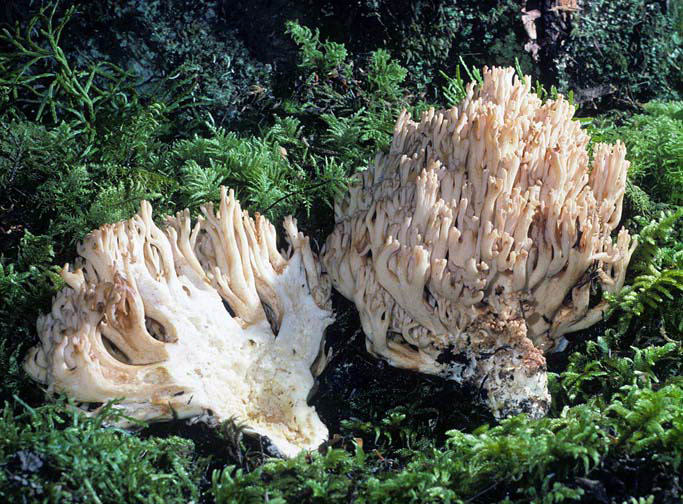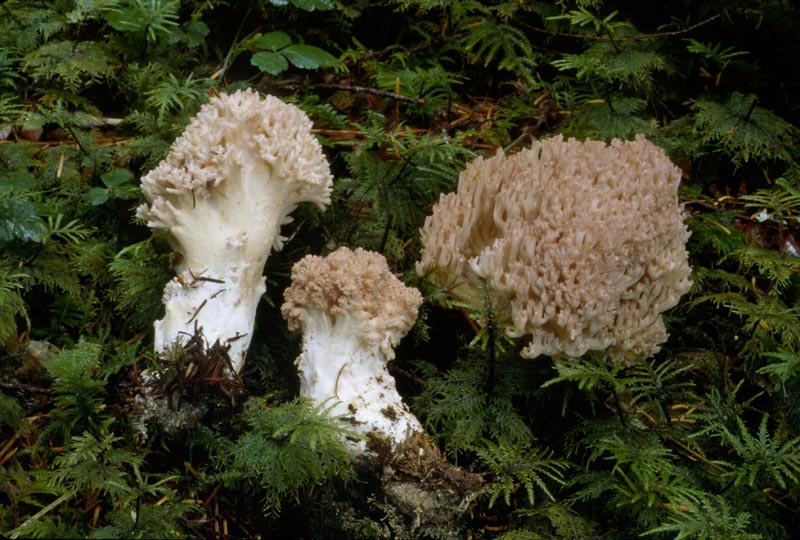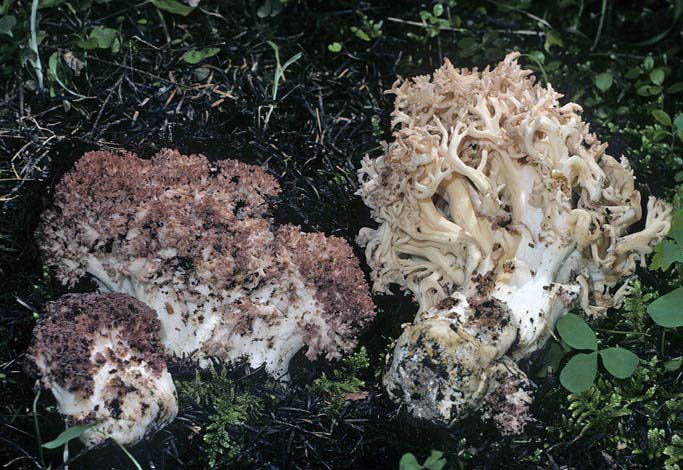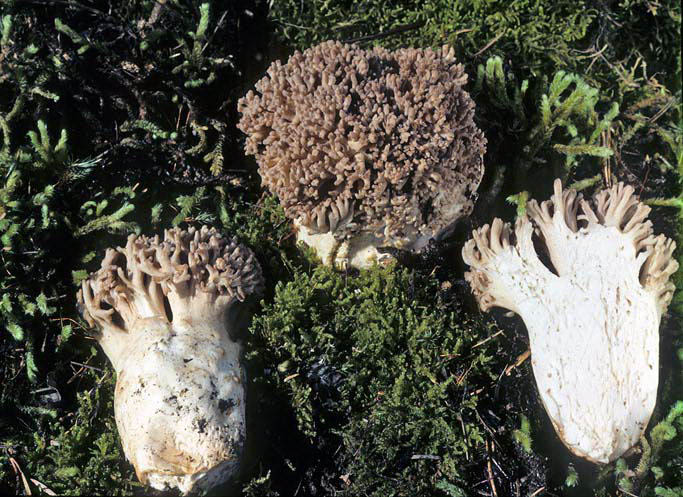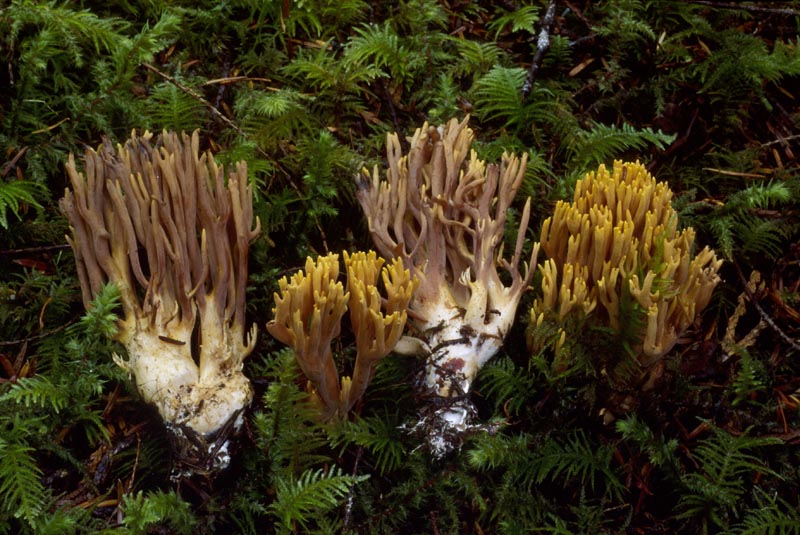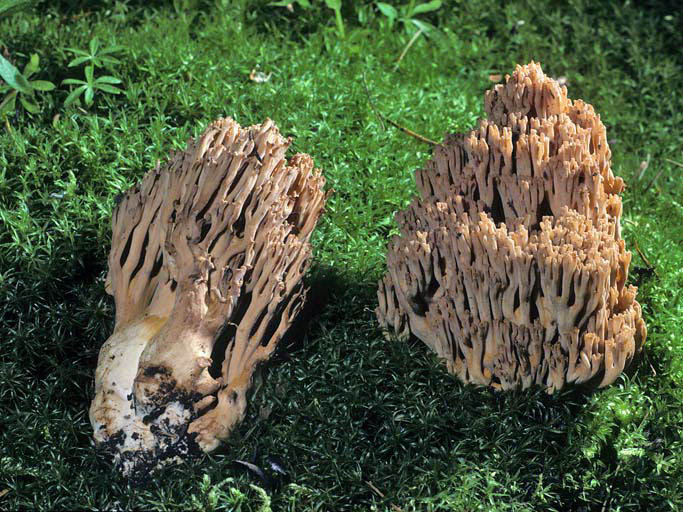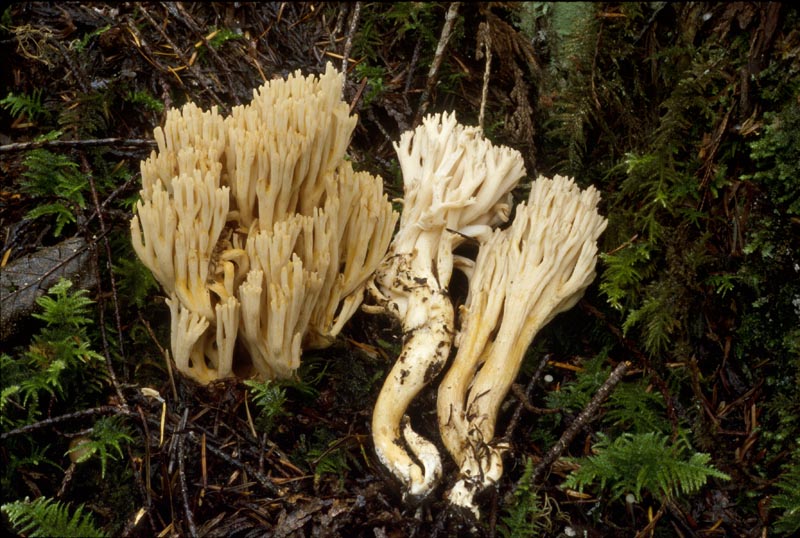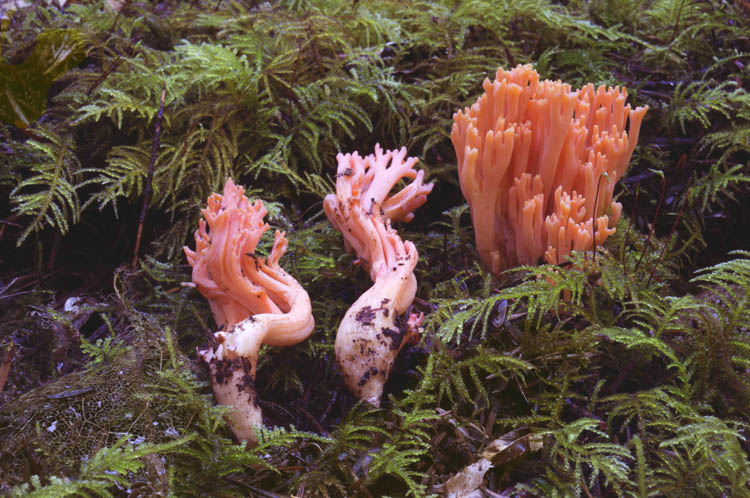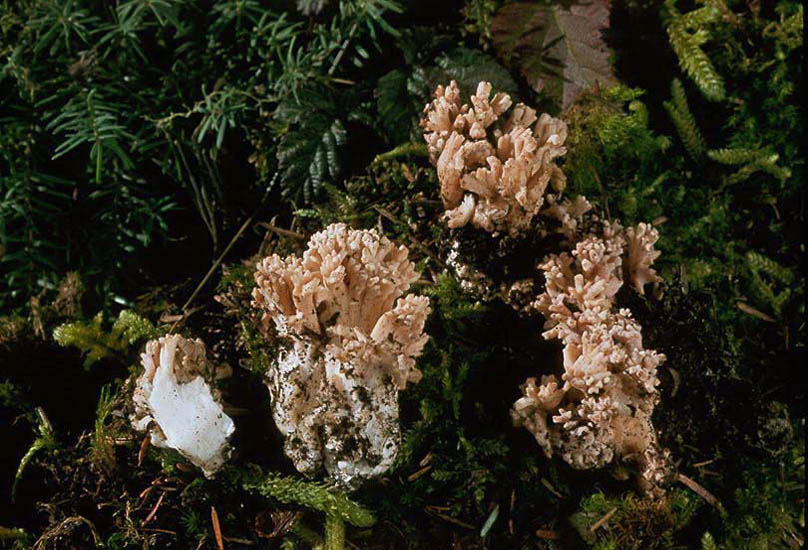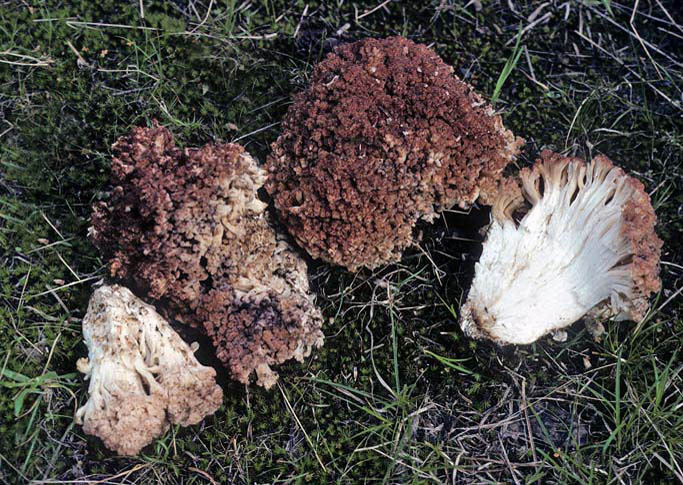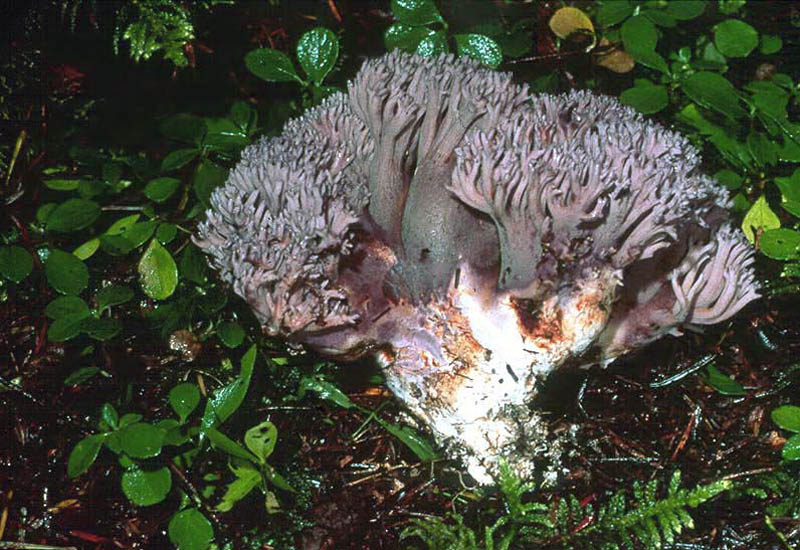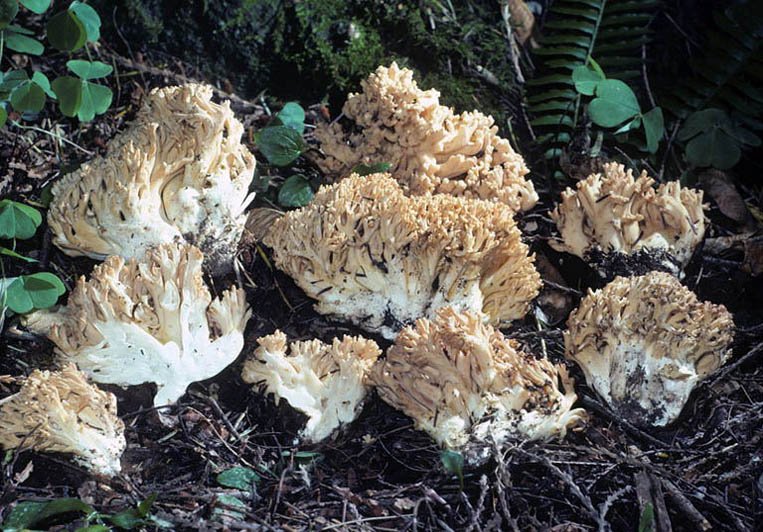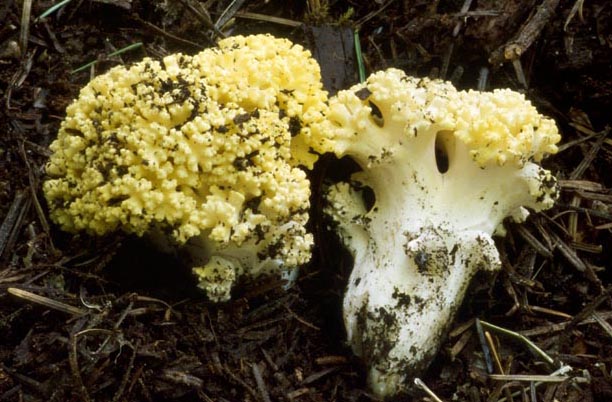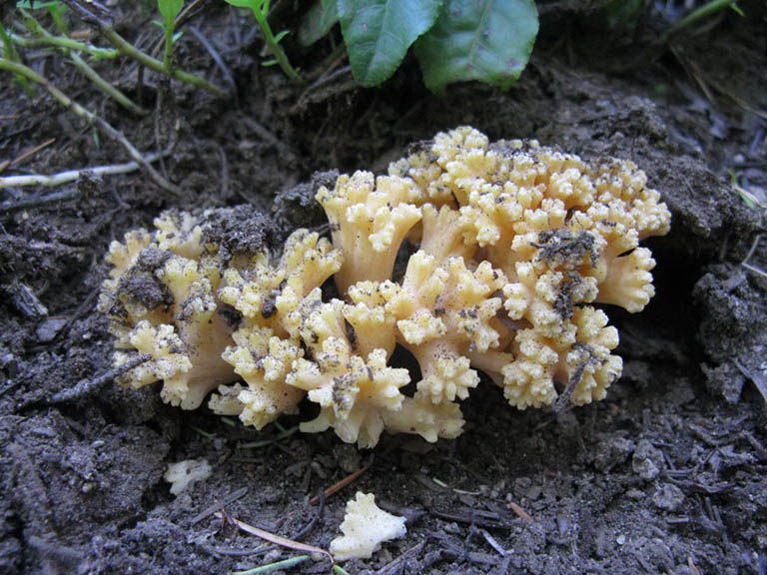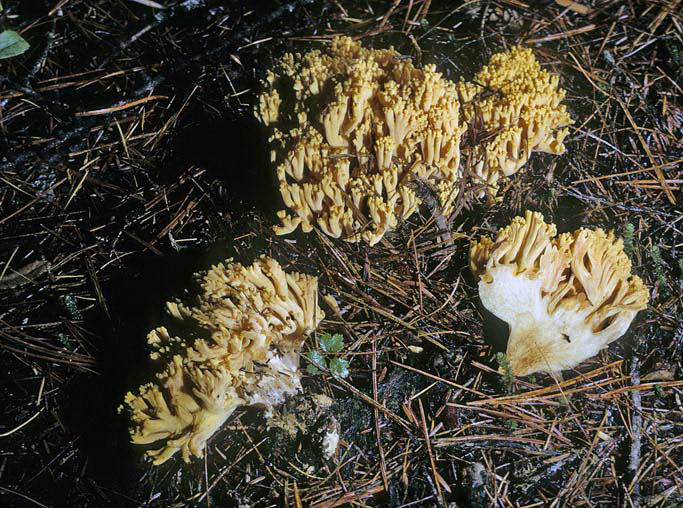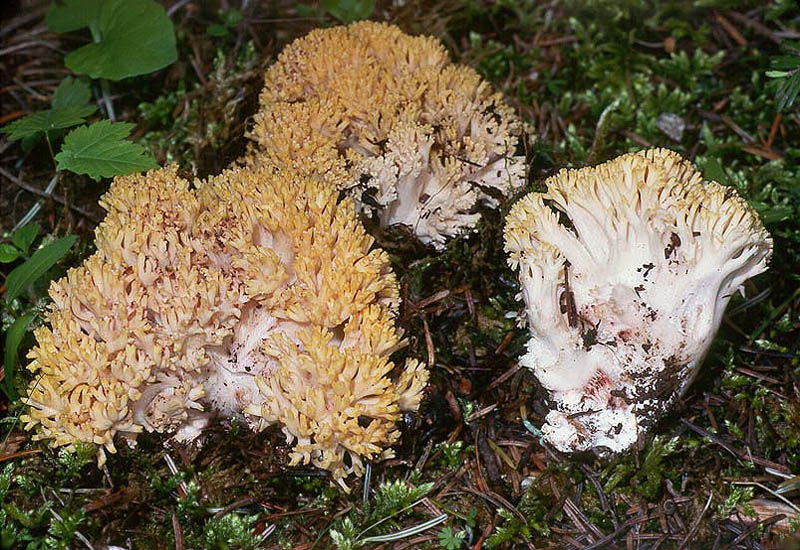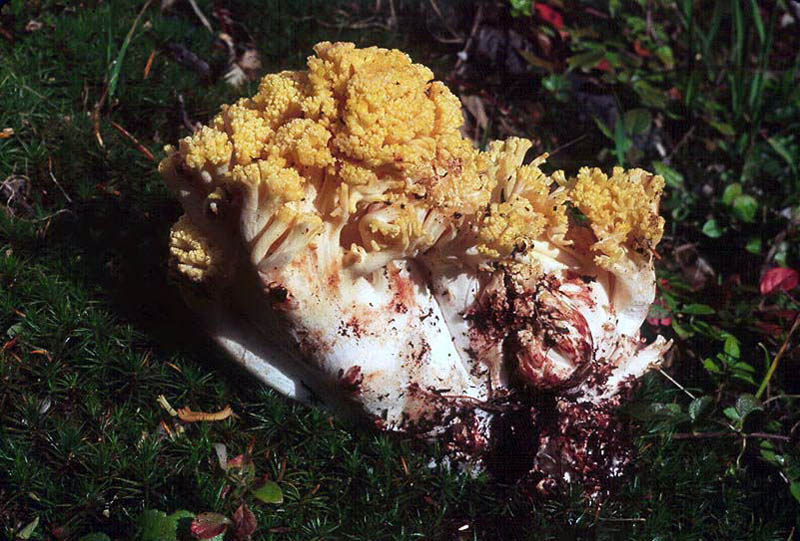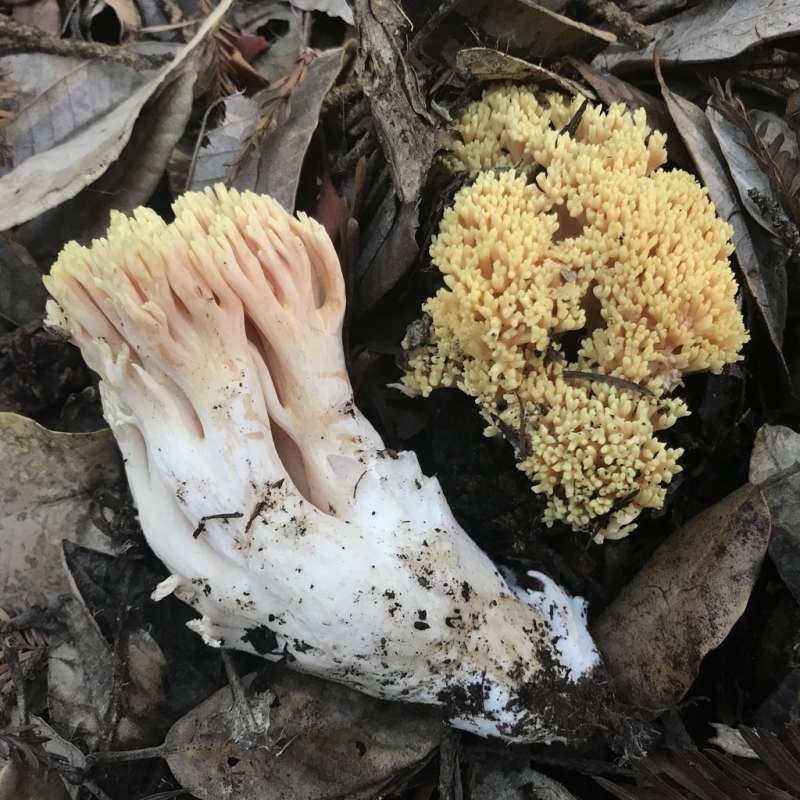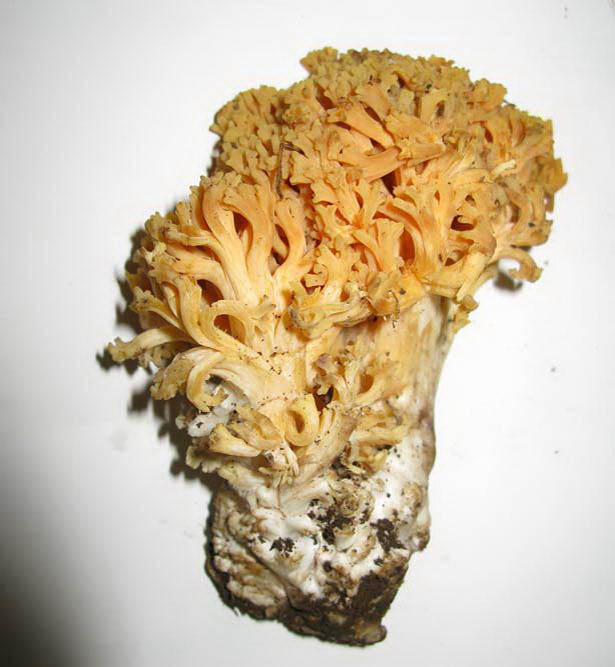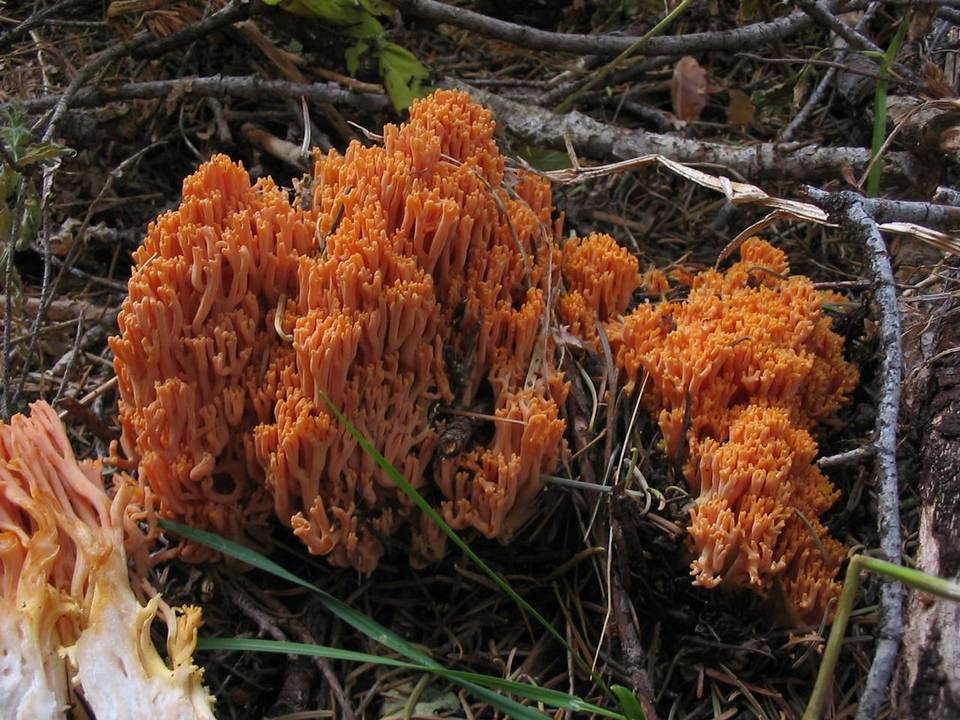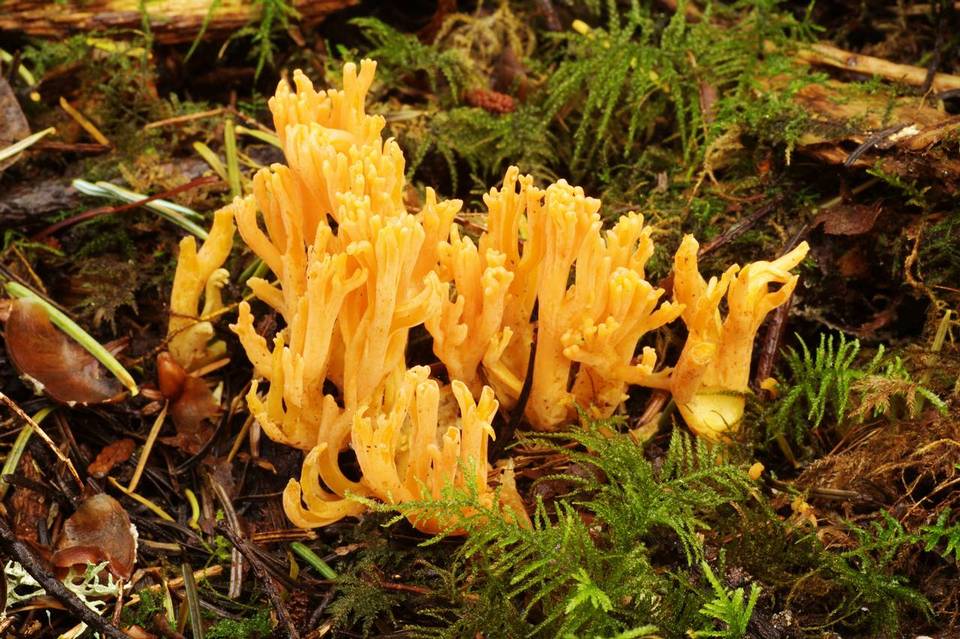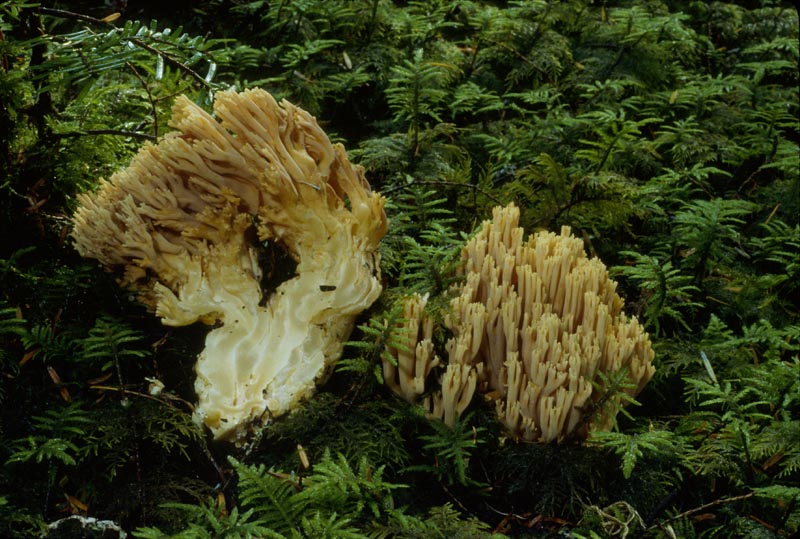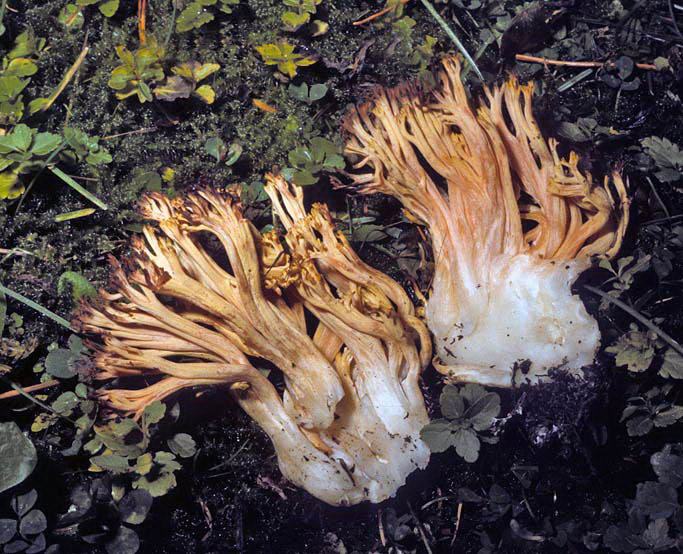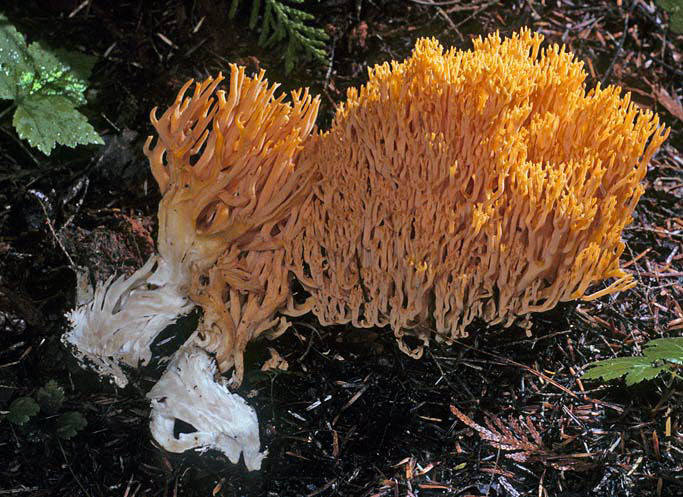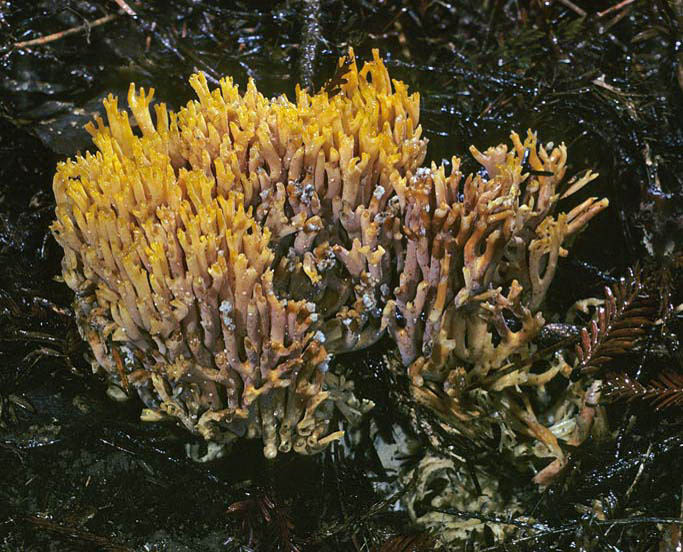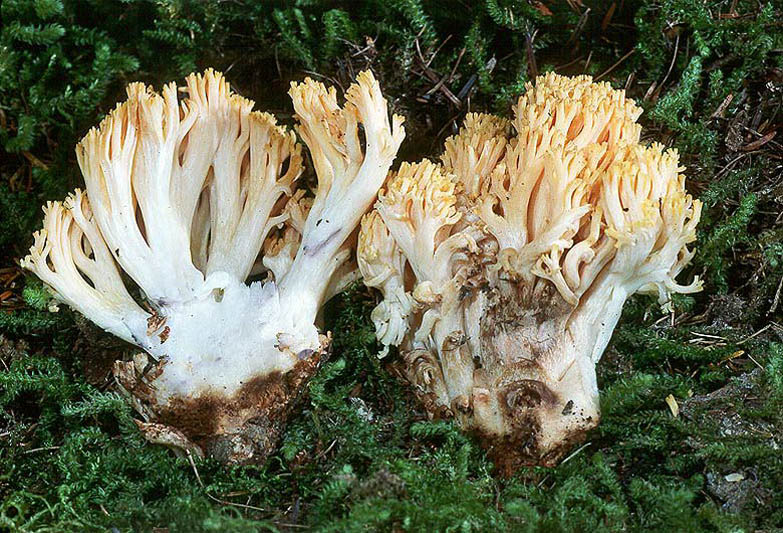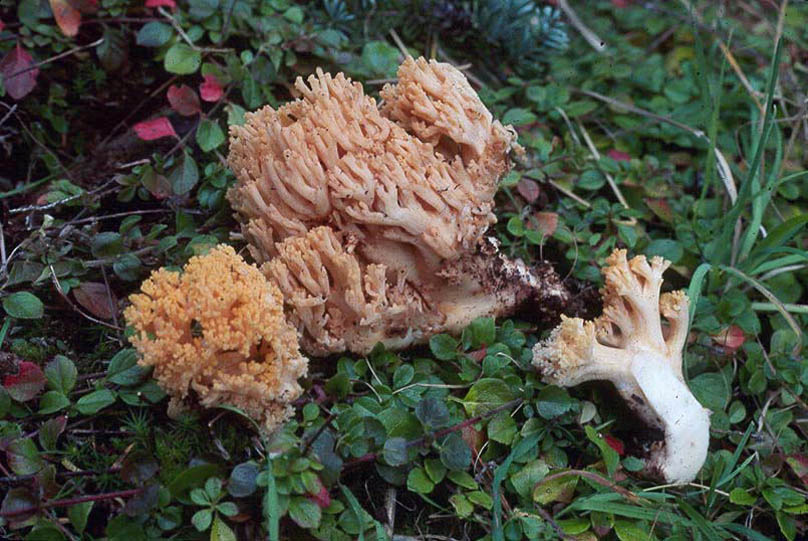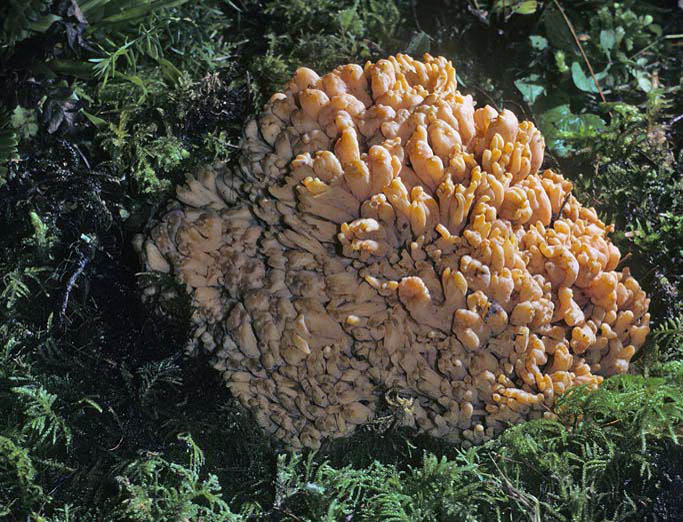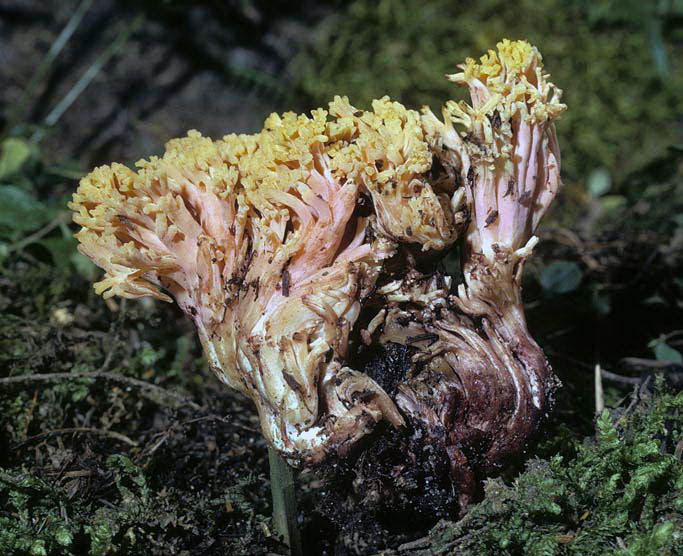Corals
Make sure your "coral" isn't too much like
plant material.
It may be a lichen, a symbiosis between a fungus and green algae
or cyanobacteria, found on wood, bare ground or even bare rocks,
unrelated to the fungi on this page. Lichens are not covered in this
key.
X. hypoxylon grp - this flask is
unrelated, but often not covered in the pimples that identify what it
really is.
Key to Corals:
Sparassis/Cotylidia/Stereopsis - first the
fan
shaped species. These are pale with wide, flat "petals". When
young, there may not be multiple petals and they will not be coral shaped and difficult to
find here. Stereopsis is never coral shaped, but its similarity to Cotylidia
seems to make this page its best fit. Sometimes slightly
veined underneath the lobes, and perhaps might be
searched for in that category. Found on the ground.
Saprophytic.
Sparassis radicata ('crispa') - the cauliflower mushroom
(although perhaps it should be called the noodle mushroom). Up to 50cm
across, smooth wide petals, found on the
ground. A member of the Polyporales.
A prized edible for its long shelf life.
Saprophytic.
Cotylidia diaphana - whitish, fan coral. <5cm.
Hymenochaetales.
C. pannosa - orange fan, somewhat coral like.
<5cm.
Stereopsis humphreyi - <3cm, true stem,
and a cleft but
not
coral fan. Coastal.
Hymenochaetales.
Thelephora/Craterellus/Polyozellus - dark coloured
fan or tube shaped mushrooms found on the ground. Thelephora has brown nodulose
spores. Polyozellus has white nodulose spores. They may all be mycorrhizal.
T. terrestris - wide fans, <10cm. Thelephorales.
T. caryophyllea - wide fans, small, delicate
with fringed edges. <5cm
T. palmata - tube to fan-shaped branches,
stinks to high heaven! <10cm.
T. caespitulans - much like
a small T. palmata without the odor, <2.5cm
Polyozellus multiplex grp - the blue
chanterelle, growing in large clusters 15cm high and
even wider. Thelephorales. See their page for species details.
Craterellus calicornucopioides - Not to be confused with this
delicious black chanterelle, with veins that are
particularly hard to detect. Cantharellales.
Tremellodendropsis
Tremellodendropsis
tuberosa - somewhat gelatinous, tough and not very brittle.
Pinkish-tan,
growing on the ground. Less highly branched than
Ramaria, Lentaria and
Clavulina, but easily confused with Clavulina
rugosa. <10cm high. Probably
saprophytic.
In the order Sebacinales or Auriculariales.
Clavulinopsis/Ramariopsis - There is
something a little bit "cleaner" and more delicate about these few corals
than the multitudes that will come next. It's hard to explain, like
Hydnum vs. Sarcodon. Clavulinopsis has both a club and
a coral shaped mushroom, and Ramariopsis is closely related but with spores with
small spines. They are in the Agaricales and found on the ground. Some
are rumoured to be mycorrhizal, I
am unclear.
Clavulinopsis corniculata - <9cm, like
Calocera viscosa but brittle,
not jelly, and on the ground.
Sometimes club-shaped.
Ramarias are larger and denser.
Ramariopsis crocea - <1.5cm, much smaller, more
delicate and brighter.
Clavulina - small, white to yellowish to grey corals found on the ground, easily confused with pale Lentarias or
Ramarias (which are sometimes on wood and often bitter), but neither are nearly as common.
Clavulina is more likely to have "busier" branch tips and be closer to
white overall. They are
mostly <10cm. They are
mycorrhizal, and related to chanterelles! (Cantharellales).
C. coralloides (cristata) - whitish, highly
branched with toothed crests at the tips. Not a clean white like
Ramariopsis, but usually whiter than Ramaria,
with busier tips.
Grey specimens are parasitized by
Helminthosphaeria clavariarum (a flask).
Pimples visible under a hand lens.
Clavulina reae -
grey branches in age, evenly coloured and no pimpling. Pale
branches are blunt like C. 'rugosa' when young.
Clavulina 'cinerea' - a second similar species of which not much
is known.
C. 'rugosa' - blunt or flattened, wrinkled, white coral,
never greying, not
highly branched. See
Tremellodendropsis.
C. 'castaneipes' - a coral with a brown hairy
stem! Branches may look like C. rugosa (pictured) or C. cristata.
Artomyces - recognized by the tips forming a round crown shape.
In the Russulales.
Artomyces piperatus - creamy coral with crown shaped tips
on wood. Tastes hot!
Artomyces cristatus - each fruitbody only has a few branches, if
any.
Lentaria -
small, much like Clavulina but sometimes bitter, not as highly branched and with white tips
that look less "busy". Found on conifer wood, like some
pale Ramarias (which are usually taller). Abundant white rhizomorphs (mycelial
threads) at the base. Probably
saprophytic.
Lentaria pinicola grp - pale white, yellow to tan with white tips, darkening
when handled, on conifer wood. May be bitter. <5cm, and not taller than it is
wide.
Less busily branched than Clavulina. Usually whiter than the small
Ramarias on wood.
Lentaria epichnoa - reported from BC.
Ramaria - the classic common PNW
large and colourful coral mushrooms, although some of them are small
and drab as well, and can be confused with previous species on this page.
The bright orange ones are larger and more complex than
Clavulinopsis/Ramariopsis. Ramarias have spores with warts and/or ridges. Currently, Ramaria
is divided into four subgenera, but these groups are not their own closest
relatives so they will probably get four different genus names in the future.
The veined club-like fungi Gomphus, Turbinellus
and Clavariadelphus are found in between
different subgenera of Ramaria. Also, many species of Ramaria have two to
five varieties described that some people distinguish, which are not covered
here. Many Ramarias are mycorrhizal,
but subgenera Echinoramaria (now called Phaeoclavulina) and Lentoramaria often grow on wood and may be
saprophytic. Ramarias are very
difficult to ID because there are so many similar species and the bright colours
of young fruit bodies will fade as they age and they all end up brownish. They
may fade within an hour or two of picking! Fresh
young specimens are usually necessary.
There are a few chemical tests that can help you identify Ramarias. Iodine
will turn the stem flesh black in a few species, and FeSO4 will turn the
flesh inside the base of the stem green in a few others.
Here are a bunch of old Ramarias, some of which could literally
be almost anything. Maybe they used to be bright red, pink, salmon,
violet or orange. Even bright yellow species might age to brownish. Who
knows.
Subgenus Echinoramaria (now known as Phaeoclavulina) - small corals with pale
yellow-brown colours, found on the ground. These usually taste bitter. Usually <5cm, with
rhizomorphs
around the base like Lentaria. Spores more sharply spiny. Most easily confused
with Clavulina, which is never bitter and more whitish or grey, and
with subgenus Lentoramaria (covered next, so check there too). Drab Laeticolora,
further below, are taller.
Phaeoclavulina abietina - yellowish branches turn green on handling.
Tall, <10cm. (See also Ramaria apiculata in Lentoramaria.)
P. mutabilis - the stem turns slightly green.
P. glaucoaromatica - everything turns green except the bright
white stem base. Smells like maple when dried. Idaho.
P. myceliosa - yellowish. Branches said to be more open.
P. curta - branches said to be smaller and more congested.
P. eumorpha - yellowish rhizomorphs at
the base instead of the usual white.
|
P.
incognita - stem said to turn brown in age or when handled.
P. argentea - stem turns brown as well, branch tips
often white. |
Subgenus Lentoramaria - contains more small, pale, blah
corals, found either on the ground or on wood. They, too, often
taste bitter. They could also easily
be confused with Clavulina and
Lentaria as well as with anything in subgenus Echinoramaria (but those are
shorter or differently coloured). Spores more
bluntly warty. This section may not all be related, and may need to be further
split up. Drab looking Laeticolora, further below, are taller, brown or
yellowish or pale and found on the ground, whereas the tall species in this
section are usually found on wood.
Ramaria rubella - when fresh with pink tones and
white branch
tips, on the ground. May grow >5cm.
R. suecica - pale pinkish tones,
white branch tips, on the ground. ~5cm.
R. gracilis/rainierensis - drab. R. gracilis has whiter
branch tips, found on the ground. Usually
~2.5cm.
R. apiculata - tips sometimes turn green (like the
lower branches of Phaeoclavulina abietina)
but on wood. Not as yellowish, but sometimes reddish. <8cm.
R. tsugina - similar.
R. stricta - taller than wide, branches
vertical, yellow tones, on
wood. <15cm. Bruises brown where handled. Always
bitter.
R. acrisiccescens, below, is similar but on the ground.
R. concolor - may be the same as R. stricta without yellow
tones, on wood. <15cm. Also bitter.
| Also consider subgenus Laeticolora, further below,
for tall, drab species that are either brownish or found on the ground. |
Subgenus Ramaria (R. botrytis grp) - bushy
cauliflower shaped corals as much as 10-20cm high or wide that are generally pale with bright
pink to purple tips when young, found on the ground. The pink may fade, and the
stem
flesh usually discolours in age. You might
notice that they all look alike. Most other red Ramarias are a different shade
of red that is also in the branches or not cauliflower shaped. The stem flesh is amyloid, meaning it eventually darkens in iodine, and this group has the longest
spores in Ramaria.
Ramaria botrytis - tips pale red or lilac (pale orange
in one variety), weakly amyloid.
R. rubrievanescens - branch tips quickly fade from peachy
pink or light orange to white,
quicker amyloid reaction.
R. rubripermanens - the only one with stem
flesh that doesn't discolour. Spring and autumn.
R. subviolacea - purplish branch tips becoming
very pale, quickest amyloid reaction. Spring and autumn.
| The following similar species belong to
subgenus Laeticolora, and are discussed there:
R. caulifloriformis has dull pink branch tips, but the stem is not amyloid.
R. botrytoides
has bright pink branch tips, and non-amyloid
flesh. Very bitter!
R.
coulterae has pink branch tips, non-amyloid
flesh and a rusty root. |
Subgenus Laeticolora - most of the large, beautiful,
colourful Ramarias found on the ground belong here. The most common
colours you will find are yellow, orange and peach, but they also
come in red and purple as well as drab colours.
The shape of different species may or may not strongly resemble the shape of
cauliflower. There are a few species that have something distinctive that helps identify
them: a rusty root (a rust coloured band of stem flesh) or a stem that
stains red wine colour (others have stem flesh that stains brown, or
not at all). Some have a yellow belly band where the upper stem has a
band of yellow around it. Microscopically, some of them have cells that are not "clamped", which is
unusual (and difficult to detect without a lot of experience), but they all seem
to be related. You will have to find a young one and note its colours, because
they fade quickly as they age making it hard to tell the difference. Some
species have a black iodine (amyloid) reaction or a green positive reaction to
FeSO4 inside the stem flesh. Do not test the outside, that is almost always
FeSO4 positive!
First let's get the drab species out of the way. These are mostly
larger than the drab Echinoramaria (Phaeoclavulina) and Lentoramaria, up to
10cm or larger, and not found on wood.
Ramaria testaceoflava - taller than wide, dark chocolate brown, with
yellow (when fresh),
bitter, slowly
stains reddish brown in age and when handled. Stem flesh green in
FeSO4.
R. marrii - chocolate without the yellow, maybe
bitter, slight brown staining, spring.
R. acrisiccescens - even taller than wide
(sometimes >20cm), paler
yellow-brown, also bitter, also staining brown.
Similar to Lentoramaria R. stricta (above).
R. velocimutans - in the yellow section, with a rusty root,
may be whitish. Stem flesh green in FeSO4.
Next up are the red or purple species. These are perhaps the most striking of any
mushrooms. They grow up to ~10cm or so in each
direction.
R. araiospora - beautiful red coral, var. araiospora has yellow
tips, var. rubella does not.
R. stuntzii - similar, usually more like
cauliflower, may have orange tones, has amyloid flesh.
R. cyaneigranosa - young red colours are more
muted, but much like R. araiospora var. araiospora.
R. caulifloriformis - cauliflower
shaped, pale pinkish tan tips that turn dark brown in age, resembles R. botrytis
but stem flesh not amyloid. Spring and fall.
R. coulterae - also cauliflower like, resembles R.
rubripermanens but stem flesh not amyloid, rusty root, spring.
R. botrytoides - bright pink tips, no rusty
root, flesh not amyloid. Very bitter!
R. violaceibrunnea (fennica/versatilis)
-
purple-grey
young branches.
R.
fumosiavellanea -
more entirely purple-grey.
R. purpurissima - brilliant purple, stocky, stem
somewhat staining.
Next let's tackle the yellow species, those that don't
have orange or peach tones when freshest, although they may turn orange-brown in
age! At that point ID gets hopeless without a microscope. They usually get up to
15cm high or so. This page has been difficult to use so far, but now it
unfortunately gets even worse. The yellow and orange Ramarias are especially
difficult to tell apart without a microscope.
R. cartilaginea - a variation of R. caulifloriformis
with dull yellow-tan tips. Cauliflower.
R. rasilispora - spring, yellow to orange-yellow
cauliflower.
Somewhat amyloid stem flesh.
R. magnipes - spring clone of R.
rasilispora, also amyloid. Stem base is covered with a soft white
coating and may stain brown.
R. thiersii - spring at high altitudes, pale yellow, flesh
somewhat browning.
R. cystidiophora - brightest yellow, erect not
cauliflower-like, smells
sweet, like
licorice, floral or bean-like, stem may stain brown to wine.
One variety has colours like R. formosa.
R. flavobrunnescens - less bright yellow,
floral smell, stem not staining but stem flesh somewhat
yellow-brown.
The following are somewhat distinctive for having a "rusty root" or wine-staining base, much more discoloured than the typical brown staining Ramarias.
R. velocimutans - white to yellow, rusty root. Stem flesh bright
green in FeSO4. May grow up to 30cm!
R. vinosimaculans - ivory to creamy yellow, wine staining base.
R. rubiginosa - very similar
coral, wine
staining base. Perhaps faintly FeSO4+ or I+.
R. synaptopoda -
a more compound stem with small wine stains, smaller, ~5cm
This is the only species with a gelatinous context in the stem to sometimes be yellow without any orange shades.
R. flavigelatinosa - four varieties with gelatinous stem flesh
like R. gelatinosa, may have sweet or bean-like odor.
Branches may be yellow or orange.
Finally, the confusing array of orange Ramarias. Some
are more peachy with yellow tips (the "formosa" colour scheme) and
others are orange with yellow tips or just orange. Every Ramaria
kind of looks orange-brown when it's old. Also growing to 15cm or so.
R. formosa - peach branches, yellow tips, flesh browns
where handled, usually thick stem.
R. cystidiophora may be similarly coloured, but smells of
licorice.
R. conjunctipes - formosa-like, tall with narrow sparsely branched
stems joined at base. No staining.
R. raveneliana is a smaller version (<4cm)
R. leptoformosa - another tall formosa-like species,
brighter colours, more orange than peach. No staining.
R. rubricarnata - a spring formosa with amyloid flesh.
Flesh does not stain strongly, yellow belly band. Fall fruitings
look much like R. formosa.
R. largentii - completely orange, sometimes brightest at
tips, wide and dense.
R. longispora - orange with yellow tips,
yellow belly band, no staining.
Single, often swollen stem.
R. aurantiisiccescens - also completely orange especially
at tips, less dense, yellow belly band.
R. armeniaca - also usually brightest orange at the tips,
no belly band,
spring.
The following species have a gelatinous context in the stem and are difficult to tell apart.
R. gelatinosa - very gelatinous inside the stem,
formosa
colours when fresh.
R. verlotensis
- cauliflower shape
w/overall pinkish-yellow colours, somewhat
gelatinous
R. flavigelatinosa - four varieties with gelatinous stem flesh
like R. gelatinosa, may have sweet or bean-like odor.
Branches may be orange or yellow.
R. sandaracina - three varieties with
orange to salmon branches and sometimes a sweet or
bean-like odor, indistinctly to distinctly gelatinous stem
flesh, sometimes with a
yellow belly band.
R. gelatiniaurantia - two varieties, one distinctly gelatinous with deep
orange branches and tips and a yellow
belly band and the other less gelatinous, with apricot yellow branches and
yellow tips.
The following are somewhat distinctive for having a "rusty root" or wine-staining base, much more discoloured than the typical brown staining Ramarias.
R. amyloidea - formosa colours with a rusty
root, strongly amyloid. Stem flesh green in FeSO4.
R. celerivirescens - rusty root "formosa"
like R. amyloidea but only weakly amyloid. Stem flesh also green in
FeSO4.
R. 'claviramulata' - a chubby deformed R.
celerivirescens, but not a distinct species.
R. rubribrunnescens - formosa colours with
wine staining base.
R.
maculatipes -
similar, slow amyloid reaction (45 min)
There is a beautiful full colour book with many more species
than shown here, Ramaria of the
Pacific Northwestern United States by Ronald L. Exeter, Lorelei Norvell and
Efrén Cázares
available
here. You should at least
download and print the free poster and hang it in your room.

